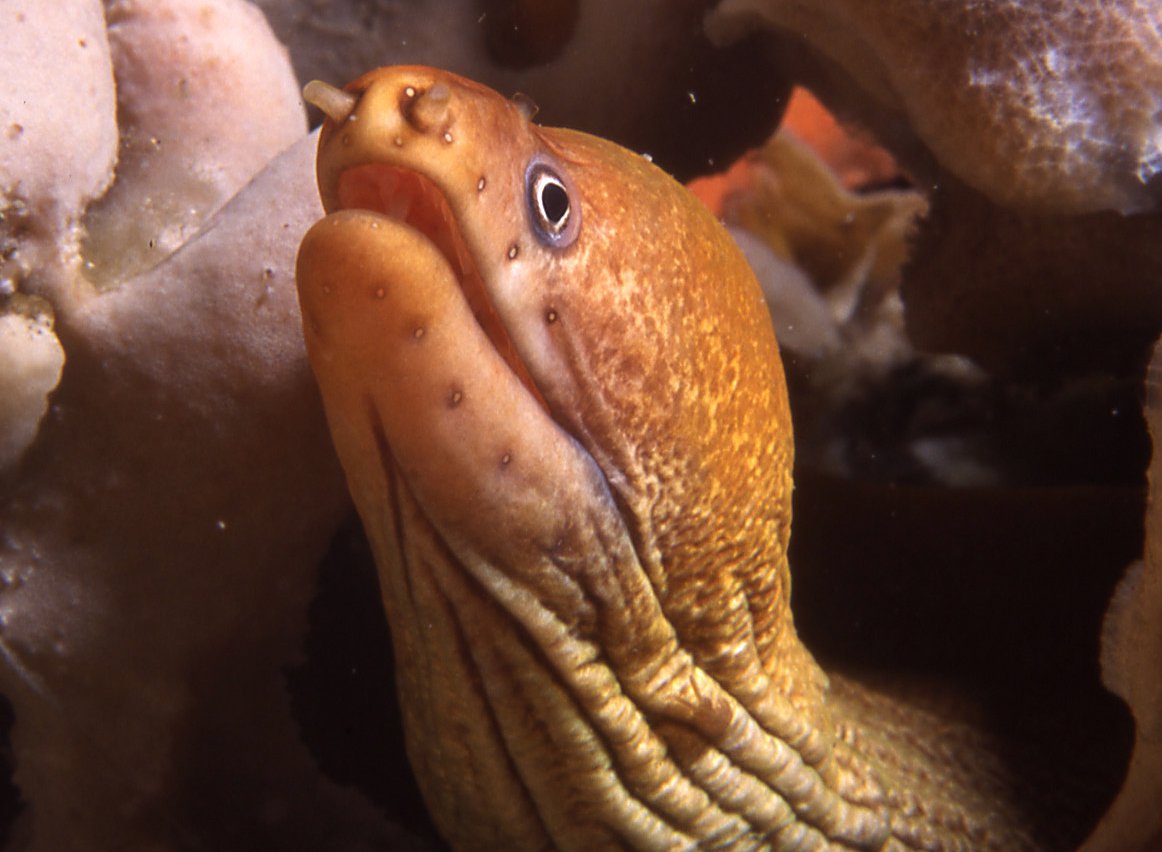Green Moray, Gymnothorax prasinus (Richardson, 1848)
Brown Reef Eel, Green Eel, Green Reef Eel, Pettifogger, Southern Green Moray, Sydney Green Eel, Yellow Moray
Introduction
Despite their fearsome appearance, morays are not considered dangerous to people. In Australia the Green Moray occurs in temperate coastal waters.
Identification
The standard name of the species comes from the yellowish-brown to green colouration of the fish. The head is usually orange.
The scientific name Gymnothorax prasinusis is made up of the following Greek words:
- gymno - bare, naked (Greek)
- thorax - chest (Greek)
- prasinos - leek green (Greek)
The Family name, 'Muraenidae', is derived from:
- the Latin term muraena, meaning 'eel',
- the suffix '-idae' means it a family name. All animal family names end in '-idae'.
Habitat
Green Morays can be found in shallow rocky reefs, weed-covered reefs, in estuaries and in deeper offshore waters. They are usually seen with only the head protruding from a crevice in the rocks or occasionally a person-made object such as a pipe.
During the day, many morays are found in crevices and holes in both rock and coral reefs. This habit affords the moray protection from predators and allows it to strike at prey from a hidden position. Despite their reclusive habits, in some places Morays make up a huge proportion of the carnivorous fishes. On some reefs in Hawaii morays make up 46 percent of the total weight of carnivorous fishes.
Distribution
Moray Eels occur in all tropical and temperate oceans of the world. In Australia the Green Moray occurs in temperate coastal waters from south-eastern Queensland to Shark Bay, Western Australia, including northern Tasmania.
The map below shows the Australian distribution of the species based on public sightings and specimens in Australian Museums. Click on the map for detailed information. Source: Atlas of Living Australia.
Feeding and diet
All morays are carnivorous (meat eaters). Their teeth vary in size and shape, from the huge fangs of the Dragon Morays, genus Enchelycore, to the low, rounded teeth found in the genera Echidna and Gymnomuraena. Morays of the genus Gymnothorax have large mouths and an impressive array of teeth. The Green Moray's mouth extends back to well behind the eye. The large, sharp teeth are arranged in single rows in both jaws and also in a row along the roof of the mouth.
Other behaviours and adaptations
Moray eels have no pectoral or pelvic fins. They have the ability to tie their bodies in knots and use this to gain leverage when tearing food. It was long thought that this was only a story, not based on fact, but has since been verified.
Tubed nares (nostrils)
Morays have an excellent sense of smell, and have the nares (nostrils) developed into tubes. Most fishes have two nostrils on each side of the head. Water passes in the anterior nostril and out through the posterior nostril. Under the skin, between the 2 nostrils, lies the nasal apparatus, which gives the fish its sense of smell.
For most fish species it is common for the 2 nostrils to be close together. In the Green Moray however, the nostrils are widely separated. The anterior nostrils, located on the snout are extended into tubes, whereas the posterior nostrils have shorter tubes and are situated above the eyes. The nostrils of some morays have been developed to an extraordinary extent. Those of the ribbon eel Rhinomuraena quaesita are highly developed.
Anguilliform swimming
Long, flexible fishes such as eels swim by flexing the whole body into lateral waves. This is known as anguilliform swimming. Most eels (including the Green Moray) have laterally compressed tails. The Green Moray also has well a developed dorsal fin which results in further compression of the body. This increases swimming efficiency in the same way that a flattened oar is more efficient for rowing than a rounded pole.
The morays use anguilliform swimming to great effect when they dart forward out of a crevice to seize prey (invertebrates and fishes). They can swim nearly as well backward, which is handy for entering into the shelter of a crevice or hole to avoid predators.
Anguilliform swimming is named after a genus of freshwater eel, Anguilla (view fact sheet for A. reinhardtii).

A Green Moray at a depth of 14 m, Halifax Park, Nelson Bay, February 2002.
Image: Ákos Lumnitzer© Ákos Lumnitzer
Life history cycle
Leptocephalus larval phase
The life cycle of all eels involves a larval phase during which time the developing eel is known as a leptocephalus. Unlike many (but not all) species of adult eels which are bottom living fishes, leptocephali are found in the plankton in open water. The leptocephali of the freshwater eels make incredible journeys of thousands of kilometres from the open ocean spawning grounds of the adults into freshwater streams.
Danger to humans
Despite their fearsome appearance morays are not considered dangerous to people, although larger individuals can inflict serious wounds. It has been reported that some species have poor eyesight. This may account for morays sometimes attacking the hands of divers, which may be mistaken for an octopus.
References
- Kuiter, R.H. 1993. Coastal Fishes of South-Eastern Australia. Crawford House Press. Pp. 437.
- Kuiter, R.H. 1996. Guide to Sea Fishes of Australia. New Holland. Pp. 433.
- Castle, P.H.J in Gomon, M.F. J.C.M. Glover & R.H. Kuiter (Eds). 1994. The Fishes of Australia's South Coast. State Print, Adelaide. Pp. 992.
- Paxton, J.R. & W.N. Eschmeyer (Eds). 1994. Encyclopedia of Fishes. Sydney: New South Wales University Press; San Diego: Academic Press [1995]. Pp. 240
- Tesch, F.W. 1977. The Eel. Biology and Management of Anguillid Eels. Chapman & Hall. Pp. 434.


